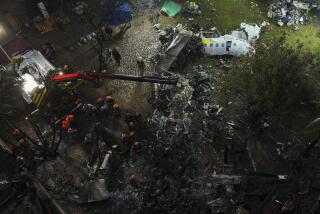Faith Is the Hunter : Crash: Students urge U.S. authorities to begin new search for five men, including a teacher’s brother, whose plane vanished in Bolivian jungle in May.
- Share via
As unlikely as it may be, the lives of five men missing in a Bolivian rain forest could rest in the hands of 860 Compton schoolchildren.
The men are members of an environmental research team whose small plane disappeared May 7 in a mountain jungle and triggered a search effort that was suspended a month ago.
The children are pupils at the Ralph Bunche Middle School who have each written a letter to President Clinton asking that the United States reactivate the search.
Youngsters are rallying around sixth-grade teacher Alfonso Soruco--whose brother is among those who have been swallowed up by the thick forest at the edge of the Andes Mountains.
Soruco is convinced that there is evidence that 41-year-old Bolivian environmental engineer Julio Soruco and the others are alive in a jungle so dense that those on the ground cannot see the sky.
“And if he’s not alive, I’m certain some of the others who were on the plane are,” said Soruco, 32, of Fullerton.
Soruco was busy Tuesday in his Mona Boulevard classroom collecting reams of computer paper on which the students have written their pleas to the President. Unfurled, the 17 strips of paper containing an estimated 900,000 words filled the floor of the school’s multipurpose room.
His classroom walls are covered with posters identifying the crash victims and the apparent map coordinates of their crash site. On a table in the back of the room is a cardboard mock-up of a jungle with tiny toy helicopters dangling over paper trees. A pasteboard replica of a satellite hangs from the ceiling by a string.
It is the satellite that has given Soruco and other victims’ relatives hope that the five are alive. They are convinced that a secret U.S. spy satellite zeroed in on the Cessna fuselage and photographed a campfire, water ditch and part of a rock “mayday” sign made by the victims.
The crash site’s high elevation, rugged terrain and tall trees have made rescue efforts difficult.
Four volunteer Bolivian searchers were killed when their similar Cessna crashed while hunting for the environmentalists--who were working with the World Bank to trace the source of gold miners’ mercury pollution in mountain rivers. Along with Julio Soruco, the missing men include a Bolivian pilot, a Bolivian official, a Canadian scientist and Harvey Olem, a 38-year-old environmental engineer from Herndon, Va.
Bolivian fliers have briefly hovered over the site and photographed what appears to be huts. But there was no place to land so searchers could look on foot, said Soruco--who spent his three-month school vacation in Bolivia assisting the search.
Bolivian soldiers got to within a few miles of the site before several were injured in falls and the expedition was called off. A helicopter borrowed from Peru had the ability to fly at the high altitude, but it was not large enough to carry enough rescuers who could rappel to the ground.
The youngsters are urging Clinton to authorize the use of heavy-duty U.S. helicopters, along with a trained rescue team able to descend by ropes from the craft.
“By now, they must be weak and frustrated. Please help them. Please rescue them,” wrote sixth-grader Teresa Perez.
Sixth-grader Tia Stuart said the missing environmentalists are heroes.
“We need those people. Just look at the people they were trying to save. The mercury was killing people and they went to go clean up all that stuff,” she wrote.
The search-and-rescue drama has captured the imagination of the whole school, according to teacher Jay Hewlett--who sent a computer e-mail message late Tuesday to the White House to alert officials that the children’s letters would be sent Thursday by an overnight shipping service.
Math teachers have turned it into arithmetic lessons. (“If you hiked 2.5 miles for 3 days, 3 miles for 2 days and 2 miles for 5 days, what was your average distance per day?”) Science classes have discussed subjects such as satellite operation and jungle vegetation. Social studies teachers have explored the culture and terrain of Bolivia and English teachers have issued reading assignments for books such as “Swiss Family Robinson.”
“We’re trying to instill in the kids that this is the way to get things done--band together,” Principal Ellie Campbell said.
But Campbell acknowledged that the children’s letters may have no effect in Washington. And even if the search is renewed, there’s no guarantee that anyone will be found alive.
“The kids are prepared. They don’t expect the President to drop everything. They know the search might not be successful,” she said.
In fact, according to one search-and-rescue expert who spent more than two weeks looking for the downed plane in June, there is “a zero chance” that a renewed hunt will pay off.
Stan Voyiaziakis, a retired Air Force lieutenant colonel from Alexandria, Va., who is a Civil Air Patrol commander and search consultant, was hired by the World Bank to hunt for the plane June 7.
“It’s very treacherous. It’s a triple-canopy forest--you can hover over the site and still not see anything,” Voyiaziakis said Tuesday.
He added that the satellite imaging thought to be that of the Cessna could be from any of 20 or so aircraft that have been reported missing over the years in the jungle.
But Soruco--who was born in Bolivia--is not giving up. And neither are his young friends at the middle school.
“The missing people have children waiting for them,” 12-year-old Banessa Duarte said. “The government needs to get going.”
More to Read
Sign up for Essential California
The most important California stories and recommendations in your inbox every morning.
You may occasionally receive promotional content from the Los Angeles Times.














